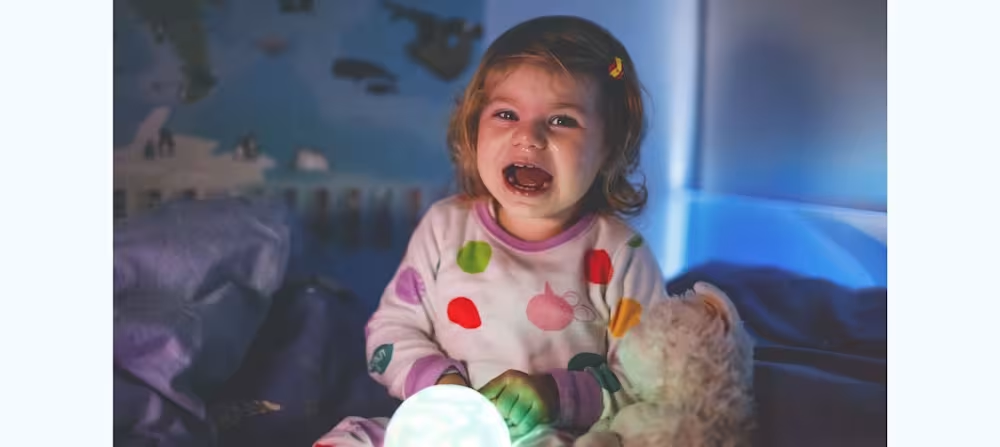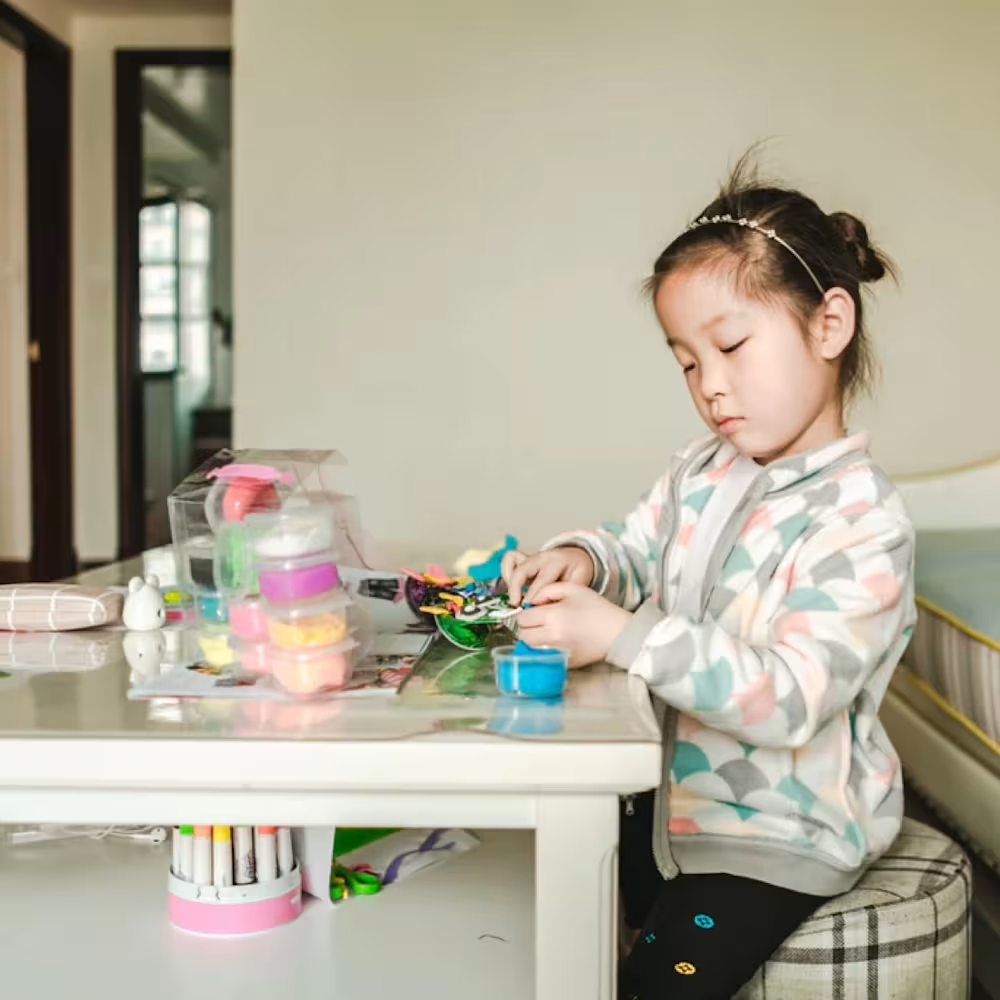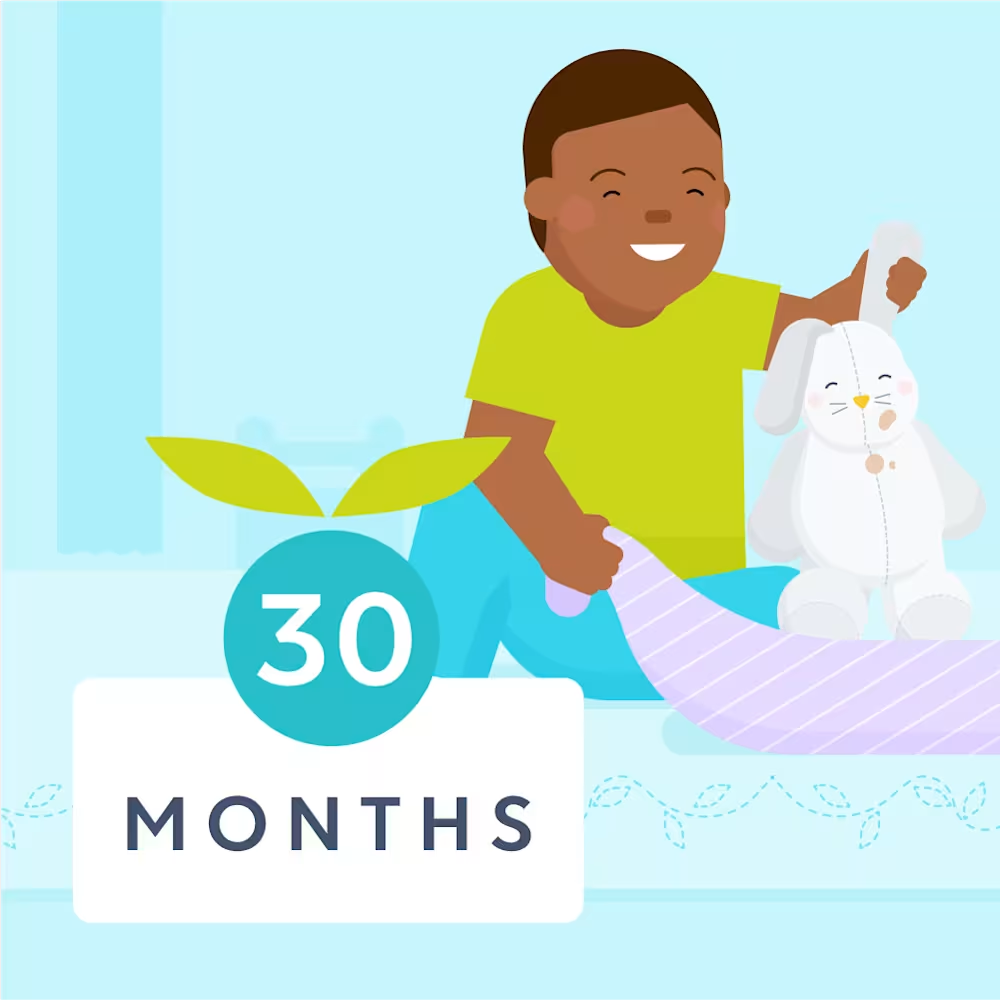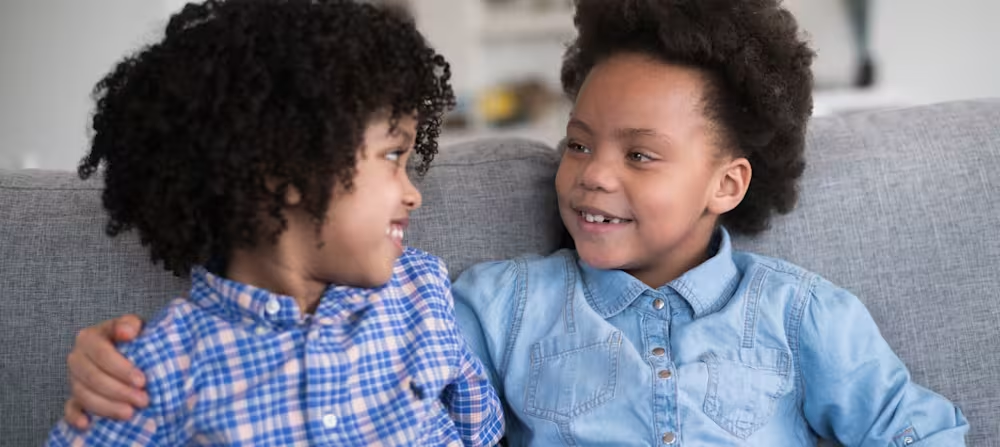3 year old sleep schedule: bedtime and nap schedule
Updated Dec 15, 2025

As your toddler becomes a preschooler, they’ll likely go through big sleep transitions. This is the age when many children give up their last nap, transition out of the crib, and say goodbye to their beloved — if they haven’t already. Those can be big adjustments for young kids (and their parents)! Fortunately, following an age-appropriate sleep schedule can help ensure these changes go as smoothly as possible.
Editor's note
The recommendations listed below represent the average amount of sleep typically needed at this age. However, please note there is a range of normal as some children have lower or higher sleep needs. Your child’s schedule may vary, and that is normal.
Table of Contents
How much should a 3 year old sleep?
The American Academy of Pediatrics (AAP) recommends 10 - 13 hours of sleep in a 24-hour period for 3 - 5 year olds []. We typically recommend aiming for at least 11.5 hours of total sleep at this age and encourage parents to also focus on other indicators (such as your child’s mood and energy levels) to determine if your child is getting enough sleep. Some kids have higher or lower sleep needs and that’s OK too.
Here's a quick overview of what you may expect when it comes to 3 year olds and sleep. Note that these figures are averages and should be used as guidelines.
| Average total sleep | 11.5 hours |
| Number of naps | 1 |
| Goal daytime sleep | 1 - 2 hours |
| Wake windows | 6 - 6.5 hours if napping |
Sample 3 year old sleep schedule
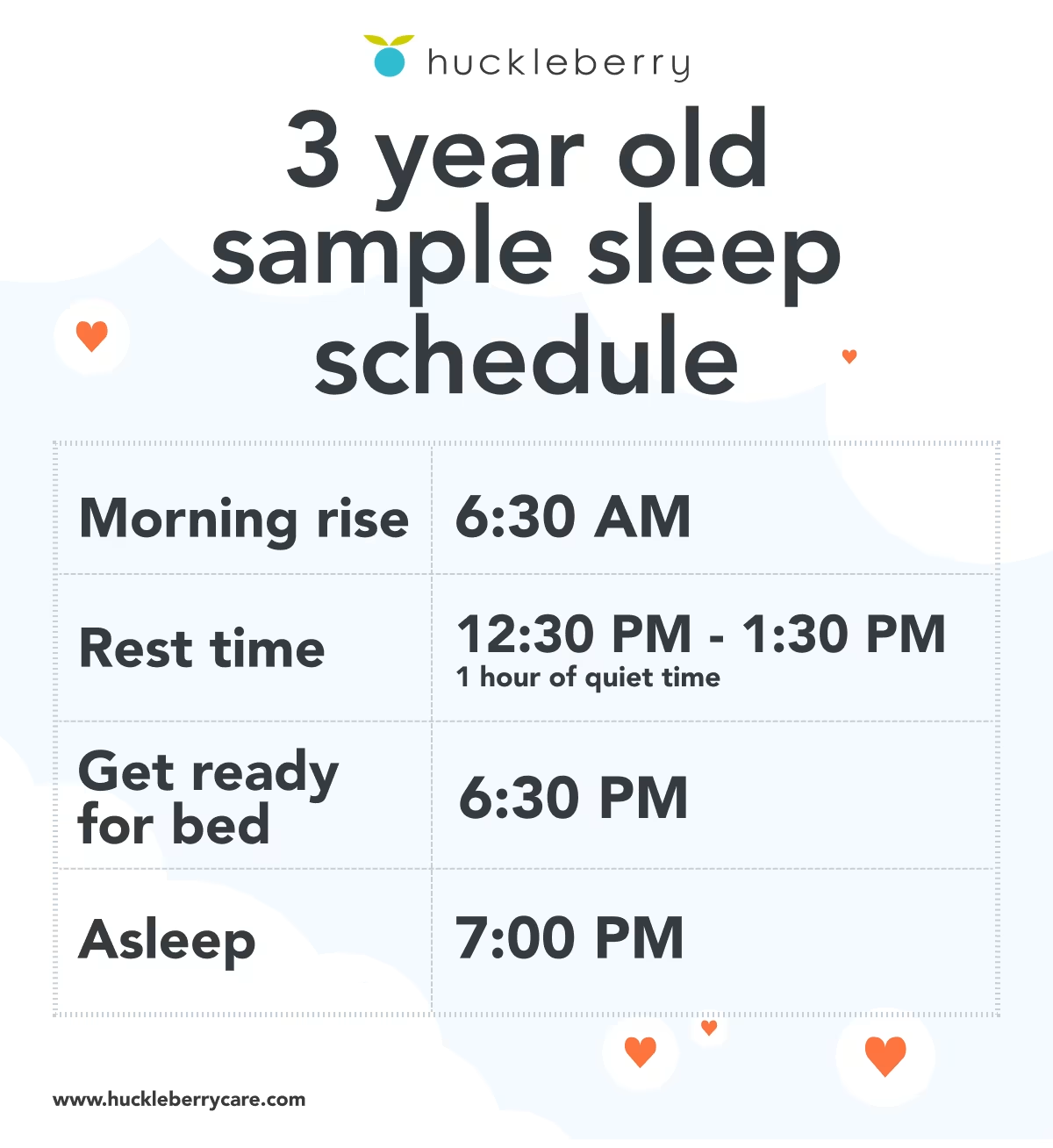
Note: Sleep needs vary by child and this chart should be viewed as an example.
Morning rise: 6:30 AM
Rest time: 12:30 PM - 1:30 PM (1 hour quiet time)
Get ready for bed: 6:30 PM
Asleep: 7:00 PM
3 year old nap schedule
How many naps for a 3 year old?
Naps can vary quite a bit at this age. We see some children continuing to nap regularly, some who are , and others who’ve dropped it entirely. There’s no “right” number of naps at this age — it’s a matter of your child’s sleep needs and your family’s schedule.
How long should a 3 year old nap?
For kids still napping, it’s common to see 1 - 1.5 hours of sleep during the day. Naps that are longer than 90 minutes can result in night sleep that’s too short. If your child sleeps less than 10 hours at night consider capping the nap or transitioning away from daytime sleep.
You may wonder. The short answer is there’s no hard and fast rule. Some children require a short nap for a little longer, others may nap occasionally until age 5. It’s not uncommon for 3 year olds to be done with naps already.
1-nap schedule
| Morning rise | 6:30 AM |
| Nap | 12:30 PM - 2:00 PM (1.5 hour nap); 6 hours of being awake before nap |
| Get ready for bed | 7:45 PM |
| Asleep | 8:30 PM; 6.5 hours of being awake before bedtime |
Note: Sleep needs vary by child and this chart should be viewed as an example.
0-nap schedule
| Morning rise | 6:30 AM |
| Rest time | 12:30 PM - 1:30 PM; 1 hour of quiet time |
| Get ready for bed | 6:15 PM |
| Asleep | 7:00 PM |
Note: Sleep needs vary by child and this chart should be viewed as an example.
Do 3 year olds nap? Transitioning to rest time
For children who no longer nap in the middle of the day, we highly recommend scheduling an official “rest time” after lunch. Establishing the designated quiet time in their bedroom (or former napping area) can give your little one a chance to decompress even if they’re not tired enough to sleep. Every once in a while they might surprise you by actually taking a nap. Either way, rest time is often a much-needed break for parents too.
If your kiddo doesn’t want to stay in their room alone, try spending 10 minutes of 1-on-1 time together in the room, just as you used to do during their naptime routine. Then offer special calm activities (such as books, puzzles, or toys) reserved only for rest time. These “rest time toys” can help make it more enticing to rest and recharge without wanting to be entertained.
If you’re looking for more support for saying farewell to naps, read more about.
Bedtime for a 3 year old
Children who still nap at 36 months and older typically have a later bedtime, often between 8:00 - 9:00 PM. Preschoolers need more awake time before their nap and bedtime (usually 6 - 6.5 hours), which can push bedtime uncomfortably late for many families.
Once your child’s bedtime starts creeping later than 9:00 PM, consider limiting or dropping the nap. Unless your child also wakes later in the morning (i.e. after 7:00 AM), a bedtime after 9:00 PM typically doesn’t allow enough sleep. This can lead to overtiredness for your kiddo and inadequate downtime for you.
Once your preschool-aged child drops daytime sleep, expect bedtime to shift earlier. You’ll want to allow them to sleep for at least 11.5 hours at night, meaning bedtime often falls between 6:30 PM - 7:30 PM. If your child is extra tired and needs a bedtime on the earlier side of this range when they first drop their nap, know this won’t last forever! Early bedtimes can be inconvenient for making plans and scheduling dinner, but over time your preschooler will be able to comfortably stay up a little later. It’s normal for there to be an adjustment period and some kids can sleep for 12 - 12.5 hours after dropping the nap.
Can you sleep train a 3 year old?
Sure! If your preschooler has a sleep-onset association at bedtime (i.e., needs your help and/or presence to fall asleep), you can help them learn to fall asleep without you in the room. Sleep training an older child may look a bit different than a baby, but the goal is the same: to improve sleep by changing bedtime habits.
There’s one caveat when it comes to sleep training at this age. While it’s never too late to establish healthy sleep routines at bedtime, naptime is a bit different. Preschoolers will often drop their nap prematurely during sleep training rather than adapt to a new way of falling asleep during the day. If you feel your kiddo still needs to nap, we typically recommend continuing to help them fall asleep at this age rather than sleep train during the day.
Is there a sleep regression at 3 years old?
If your child is newly experiencing new sleep issues (like overnight waking or early rising), we’d call this a sleep regression. At 3, transitions like not napping and moving into a big kid bed can contribute to sleep challenges. However, take comfort in knowing not all 3 year olds will go through a patch of bumpy sleep. Every kiddo is different!
Why does my 3 year old keep waking up at night crying?
A 3 year old may wake up at night if they’re overtired at bedtime, which is especially common if they’ve recently stopped napping. Overtiredness often makes it hard for kiddos to fall asleep and stay asleep.
On the other hand, children who get more day sleep than they need may wake in the middle of the night or early in the morning. In these cases, adjusting the timing or length of the nap (or dropping it altogether if they’re truly ready) can help restore balance to their overall sleep schedule.
Other reasons for new overnight waking at 3 include developmental milestones, life changes (like starting new preschool/daycare, potty training, the arrival of a sibling, transitioning out of the crib), travel, and teething — more molars! If you’re looking for more sleep support, consider submitting for a personalized, step-by-step Sleep Plan via .
Can my 3 year old sleep with a pacifier?
It’s common for caregivers to get rid of pacifiers when kiddos are 3 if they haven’t already. The American Academy of Pediatric Dentistry cautions against using pacis into toddlerhood and beyond because of the likelihood that use will create bite and teeth issues that may require orthodontic treatment [].
What are the developmental milestones for a 3 year old?
milestones include plenty of exciting things like doing more tasks independently, speaking so others can (mostly) understand them, and understanding new concepts like counting. However, there’s a wide range of normal at 3 so it’s normal if your kiddo isn’t doing all of the following things just yet.
Here are some things your child may be doing and trying at 3:
Speaks well enough to be understood, most of the time
Knows 500 - 900 words
Pedals a tricycle
Throws a ball overhand
Dresses themselves
Washes and dries hands
Strings objects together
Says first name when asked
Knows simple songs and rhymes
Shares and is learning to take turns
Draws a circle after being shown how
Easily draws straight lines
Correctly names some colors
Recognizes some numbers and understands the concept of counting
Has less frequent temper tantrums
Takeaway
3 year olds need about 12 hours of sleep over 24 hours to be sufficiently rested. This typically includes at least 10 hours of overnight sleep and a daily nap that lasts 1 - 2 hours.
Nap resistance is common around age 3, and for many children, it signals that they’re getting closer to dropping naps altogether. While some kids this age still benefit from daytime sleep, it’s also a common time for naps to phase out — especially if they’re consistently skipping them and still sleeping well overnight.
While it’s helpful to keep a consistent daily schedule, it’s also important to stay flexible. If your child skips their nap — especially several days in a row — consider moving bedtime earlier to prevent overtiredness and support better overnight sleep.
If you're curious about what lies ahead when it comes to sleep, check out a . Also take a look at a to see how far your little one has come.
3 year old FAQ
Share article:
Note: The content on this site is for informational purposes only and should not replace medical advice from your doctor, pediatrician, or medical professional. If you have questions or concerns, you should contact a medical professional.
2 Sources
Table of Contents
Share article:
